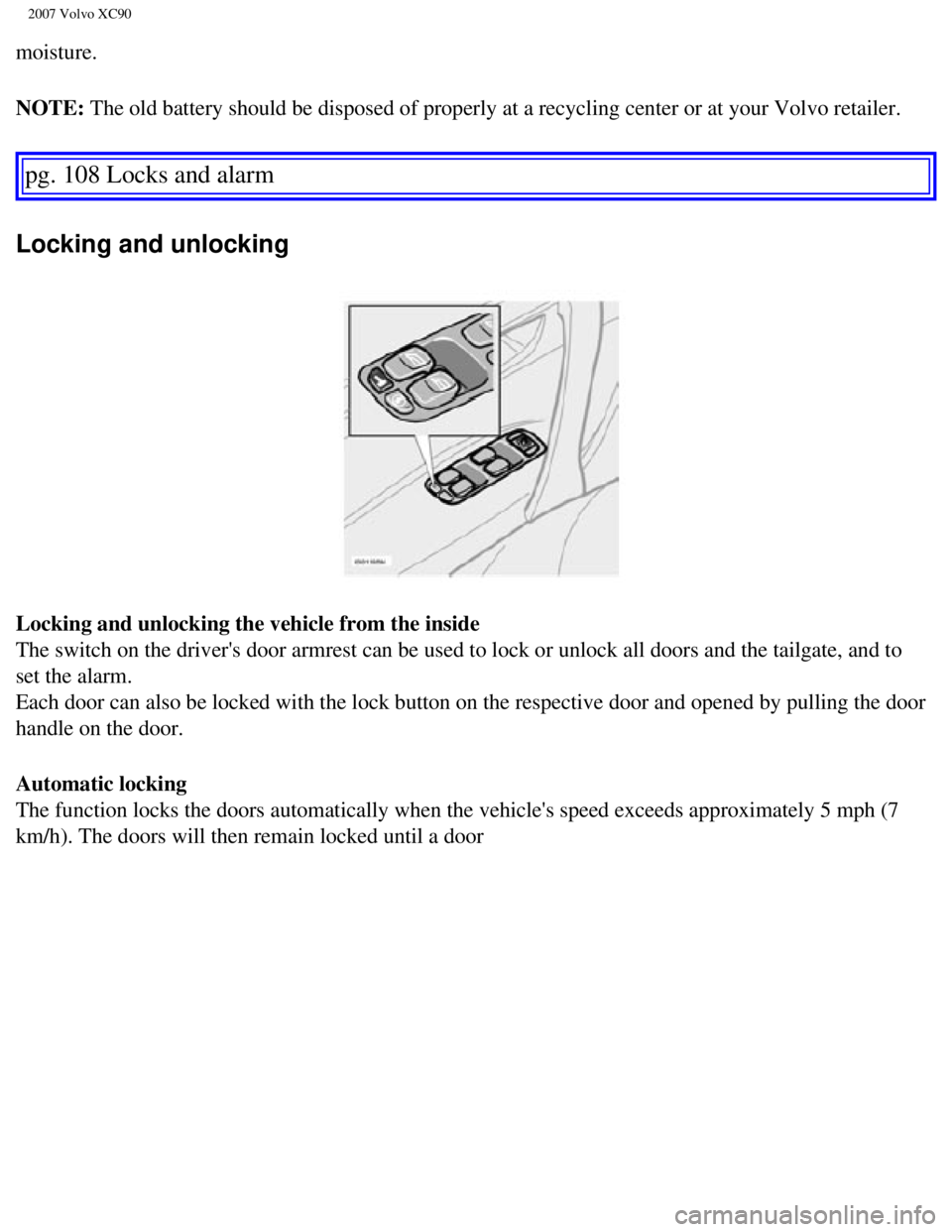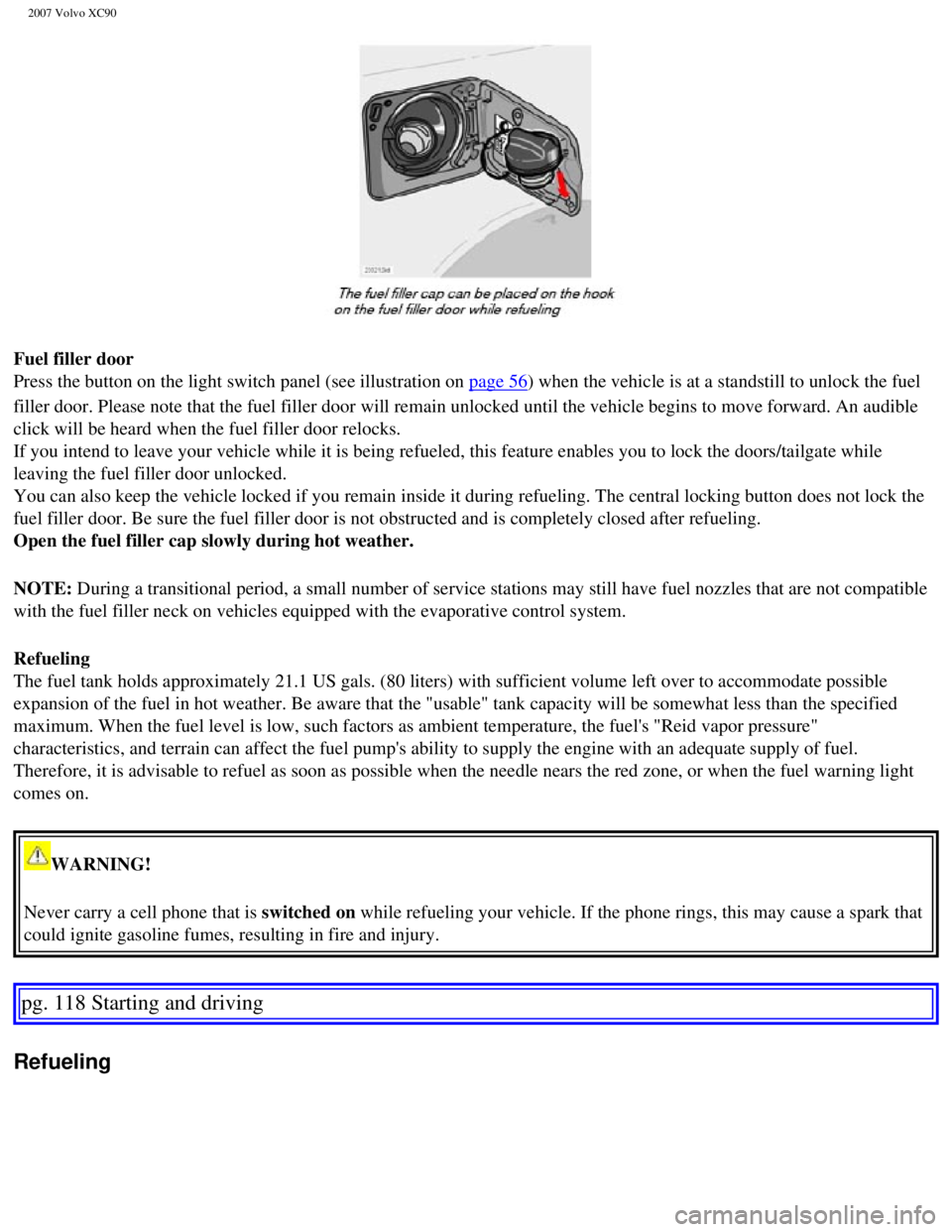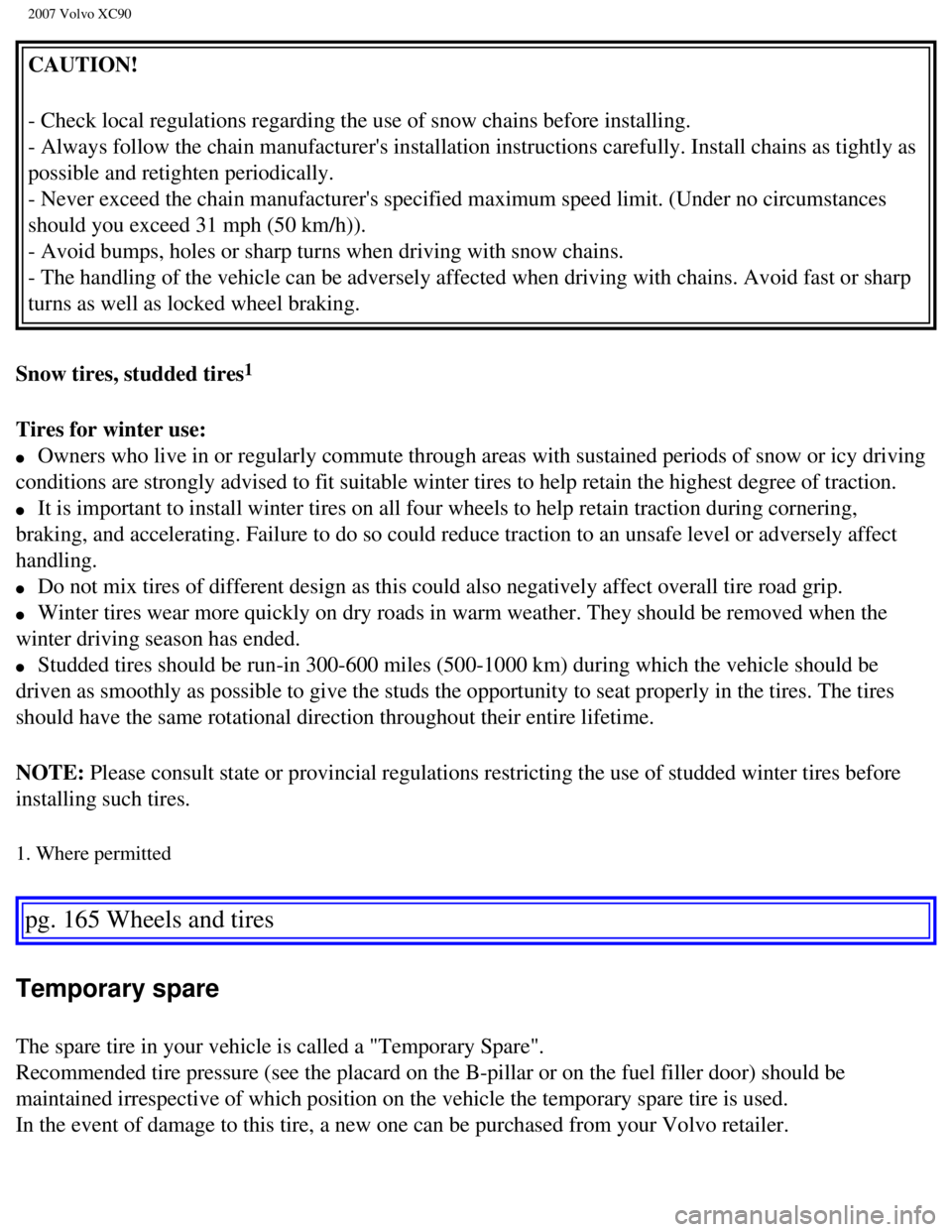2007 VOLVO XC90 door lock
[x] Cancel search: door lockPage 120 of 268

2007 Volvo XC90
this time.
Please note that this function will not unlock the doors if the engine i\
s running.
Immobilizer (start inhibitor)
Each of the keys supplied with your vehicle contains a coded transmitter\
. The code in the key is
transmitted to an antenna in the ignition switch where it is compared to\
the code stored in the start
inhibitor module. The vehicle will start only with a properly coded key.\
Each key has a unique code, which your Volvo retailer uses if new keys a\
re required. A maximum of six
remote controls/keys can be programmed and used for one vehicle. If you \
misplace a key, take the other
keys to an authorized Volvo retailer for reprogramming as an antitheft m\
easure.
If two of the keys to your vehicle are close together, e.g., on the same\
key ring, when you try to start the
vehicle, this could cause interference in the immobilizer system and res\
ult
pg. 105 Locks and alarm
Keys and remote controls
in the vehicle not starting. If this should occur, remove one of the key\
s from the key ring before trying to
start the vehicle again. This device complies with part 15 of the FCC rules. Operation is subject\
to the following condition:
(1) This device may not cause harmful interference, and (2) this dev\
ice must accept any interference
received, including interference that may cause undesired operation.
Remote controls
Your vehicle is equipped with two coded remote control transmitters with\
integrated ignition keys called
Key Integrated Remote (KIR). These transmitters use a radio frequency \
that will enable you to lock/
file:///K|/ownersdocs/2007/2007_XC90/07xc90_05.htm (3 of 7)12/30/2006 \
5:53:41 PM
Page 121 of 268

2007 Volvo XC90
unlock all doors and the tailgate from a distance of 10-15 feet (3-5 me\
ters).
The transmitters will also activate or allow "keyless" entry into the pa\
ssenger compartment or the
tailgate. They will also activate or deactivate your vehicle's alarm sys\
tem(s). The vehicle can also be
locked/ unlocked with the key.
1. Fold key in/out
2. Lock
3. Approach lighting
4. "Panic" function
5. Unlock tailgate
6. Unlock
If one of the transmitters is misplaced, contact your nearest authorized\
Volvo retailer for replacement.
Using the remote control
Button 1: Press to extend the key. This button must also be pressed when the key \
is folded back into the
slot in the side of the remote control unit.
pg. 106 Locks and alarm
Keys and remote controls
Button 2 (Lock): Press once to lock all doors, and the tailgate.
Button 3 (Approach lighting): Press this button when approaching the vehicle at night to light up the\
interior courtesy light, parking lights, license plate lights and the li\
ghts in the sideview mirrors.
Button 4 (Panic): See
page 111 for more information on this function.
Button 5 (Tailgate unlock): Press this button to unlock the tailgate (without unlocking the other \
doors).
file:///K|/ownersdocs/2007/2007_XC90/07xc90_05.htm (4 of 7)12/30/2006 \
5:53:41 PM
Page 122 of 268

2007 Volvo XC90
NOTE: This function will not open the tailgate.
Button 6 (Unlock): Press this button once to unlock the driver's door only. Wait for at le\
ast 1 second
and press the button again (within 10 seconds) to unlock all doors, an\
d the tailgate.
NOTE:
l If an airbag deploys, your vehicle's SRS control module will attempt to \
automatically unlock all
doors.
l The keys may also be used to lock and unlock the doors, and to activate \
and deactivate the alarm
system.
l To avoid leaving your keys in the vehicle, make a habit of always lockin\
g the vehicle with the remote
control.
l If the key blade section of the remote is not fully folded out when star\
ting the vehicle, the immobilizer
function may make it impossible to start the engine.
l The vehicle can be locked even if a door is open. When the door(s) are\
closed, they will be locked.
Please be aware that the keys could be locked in the car when this is do\
ne.
Automatic re-locking
If the doors are unlocked, the locks will automatically reengage (re-lo\
ck) and the alarm will rearm after
2 minutes unless a door or the tailgate has been opened. This helps prev\
ent the car from inadvertently
being left unlocked.
l FCC ID:LQNP2T-APU
This device complies with part 15 of the FCC rules. Operation is subject\
to the following conditions:
(1) This device may not cause harmful interference, and (2) this dev\
ice must accept any interference
received, including interference that may cause undesired operation.
l Canadian 2306104388
Model 504 2927 by Donnelly
Operation is subject to the following conditions: (1) this device may \
not cause interference, and (2)
this device must accept any interference, including interference that ma\
y cause undesired operation of
the device.
l Canadian 2306104388A
Model 509 977 by Connaught Electronics
Operation is subject to the following conditions: (1) this device may \
not cause interference, and (2)
this device must accept any interference, including interference that ma\
y cause undesired operation of
the device.
pg. 107 Locks and alarm
Keys and remote controls
file:///K|/ownersdocs/2007/2007_XC90/07xc90_05.htm (5 of 7)12/30/2006 \
5:53:41 PM
Page 123 of 268

2007 Volvo XC90
WARNING!
Never use the transmitter to lock the doors from inside the vehicle.
Doing so would ACTIVATE:
l the break-in alarm, which would sound if one of the doors were opened
l the optional interior motion and inclination alarm sensors.
Doing so would DEACTIVATE:
l the moonroof and interior courtesy light controls.
l the central locking buttons on the front door armrests, although the int\
erior door handles would still
function to allow occupants to leave the vehicle.
Disabled features would remain disabled until the remote is used again t\
o unlock the vehicle.
In addition, locking an occupied vehicle would hinder rapid access to th\
e occupants in an accident or
emergency.
Replacing the battery in the remote control
If the range of the transmitter is noticeably reduced, this indicates th\
at the battery is weak and should be
replaced.
To replace the battery:
- Carefully pry open the rear edge of the cover with a small screwdriver\
.
- Insert a new 3-volt, CR2032 battery, with the battery's plus side up. \
Avoid touching the contact
surfaces of the battery with your fingers.
- Press the cover back into place. Ensure that the rubber seal is correc\
tly positioned to help keep out
file:///K|/ownersdocs/2007/2007_XC90/07xc90_05.htm (6 of 7)12/30/2006 \
5:53:41 PM
Page 124 of 268

2007 Volvo XC90
moisture.
NOTE: The old battery should be disposed of properly at a recycling center or\
at your Volvo retailer.
pg. 108 Locks and alarm
Locking and unlocking
Locking and unlocking the vehicle from the inside
The switch on the driver's door armrest can be used to lock or unlock al\
l doors and the tailgate, and to
set the alarm.
Each door can also be locked with the lock button on the respective door\
and opened by pulling the door
handle on the door.
Automatic locking
The function locks the doors automatically when the vehicle's speed exce\
eds approximately 5 mph (7
km/h). The doors will then remain locked until a door
file:///K|/ownersdocs/2007/2007_XC90/07xc90_05.htm (7 of 7)12/30/2006 \
5:53:41 PM
Page 129 of 268

2007 Volvo XC90
Fuel filler door
Press the button on the light switch panel (see illustration on
page 56) when the vehicle is at a standstill to unlock the fuel
filler door. Please note that the fuel filler door will remain unlocked \
until the vehicle begins to move forward. An audible
click will be heard when the fuel filler door relocks.
If you intend to leave your vehicle while it is being refueled, this fea\
ture enables you to lock the doors/tailgate while
leaving the fuel filler door unlocked.
You can also keep the vehicle locked if you remain inside it during refu\
eling. The central locking button does not lock the
fuel filler door. Be sure the fuel filler door is not obstructed and is \
completely closed after refueling.
Open the fuel filler cap slowly during hot weather.
NOTE: During a transitional period, a small number of service stations may st\
ill have fuel nozzles that are not compatible
with the fuel filler neck on vehicles equipped with the evaporative cont\
rol system.
Refueling
The fuel tank holds approximately 21.1 US gals. (80 liters) with suffi\
cient volume left over to accommodate possible
expansion of the fuel in hot weather. Be aware that the "usable" tank ca\
pacity will be somewhat less than the specified
maximum. When the fuel level is low, such factors as ambient temperature\
, the fuel's "Reid vapor pressure"
characteristics, and terrain can affect the fuel pump's ability to suppl\
y the engine with an adequate supply of fuel.
Therefore, it is advisable to refuel as soon as possible when the needle\
nears the red zone, or when the fuel warning light
comes on.
WARNING!
Never carry a cell phone that is switched on while refueling your vehicle. If the phone rings, this may cause a spar\
k that
could ignite gasoline fumes, resulting in fire and injury.
pg. 118 Starting and driving
Refueling
file:///K|/ownersdocs/2007/2007_XC90/07xc90_06.htm (5 of 32)12/30/2006\
5:53:44 PM
Page 131 of 268

2007 Volvo XC90
- Select the desired gear. The gear engages after a very slight delay wh\
ich is especially noticeable when selecting R.
NOTE: Your vehicle is equipped with a KEYLOCK system. When the engine is switched off, the gear selector must be
in the (P)ark position before the key can be removed from the ignition switch. W\
hen starting in cold weather, the
transmission may shift up at slightly higher engine speeds than normal u\
ntil the automatic transmission fluid reaches
normal operating temperature.
NOTE: Do not race a cold engine immediately after starting. Oil flow may not \
reach some lubrication points fast enough
to prevent engine damage.
WARNING!
An extra mat on the driver's floor can cause the accelerator pedal to ca\
tch. Check that the movement of the accelerator
pedal is not impeded. No more than one protective floor covering may be \
used at one time.
1. If two of the keys to your vehicle are close together, e.g. on the sa\
me key ring when you try to start the vehicle, this could cause
interference in the immobilizer system and result in the vehicle not sta\
rting. If this should occur, remove one of the keys from the key
ring before trying to start the vehicle again.
2. On vehicles equipped with the autostart feature, release the key imme\
diately. See also
page 121.
pg. 120 Starting and driving
Starting the vehicle
WARNING!
Always place the gear selector in Park and apply the parking brake befor\
e leaving the vehicle. Never leave the vehicle
unattended with the engine running. Always open garage doors fully befor\
e starting the engine inside a garage to ensure
adequate ventilation. The exhaust gases contain carbon monoxide, which i\
s invisible and odorless but very poisonous.
CAUTION!
Automatic transmission
The engine should be idling when you move the gear selector. Never accel\
erate until after you feel the transmission
engage! Accelerating immediately after selecting a gear will cause harsh\
engagement and premature transmission wear.
Selecting P or N when idling at a standstill for prolonged periods of ti\
me will help prevent overheating of the automatic
transmission fluid.
pg. 121 Starting and driving
Economical driving
Ignition switch and steering wheel lock
file:///K|/ownersdocs/2007/2007_XC90/07xc90_06.htm (7 of 32)12/30/2006\
5:53:44 PM
Page 172 of 268

2007 Volvo XC90
CAUTION!
- Check local regulations regarding the use of snow chains before instal\
ling.
- Always follow the chain manufacturer's installation instructions caref\
ully. Install chains as tightly as
possible and retighten periodically.
- Never exceed the chain manufacturer's specified maximum speed limit. (\
Under no circumstances
should you exceed 31 mph (50 km/h)).
- Avoid bumps, holes or sharp turns when driving with snow chains.
- The handling of the vehicle can be adversely affected when driving wit\
h chains. Avoid fast or sharp
turns as well as locked wheel braking.
Snow tires, studded tires
1
Tires for winter use:
l Owners who live in or regularly commute through areas with sustained per\
iods of snow or icy driving
conditions are strongly advised to fit suitable winter tires to help ret\
ain the highest degree of traction.
l It is important to install winter tires on all four wheels to help retai\
n traction during cornering,
braking, and accelerating. Failure to do so could reduce traction to an \
unsafe level or adversely affect
handling.
l Do not mix tires of different design as this could also negatively affec\
t overall tire road grip.
l Winter tires wear more quickly on dry roads in warm weather. They should\
be removed when the
winter driving season has ended.
l Studded tires should be run-in 300-600 miles (500-1000 km) during whic\
h the vehicle should be
driven as smoothly as possible to give the studs the opportunity to seat\
properly in the tires. The tires
should have the same rotational direction throughout their entire lifeti\
me.
NOTE: Please consult state or provincial regulations restricting the use of s\
tudded winter tires before
installing such tires.
1. Where permitted
pg. 165 Wheels and tires
Temporary spare
The spare tire in your vehicle is called a "Temporary Spare".
Recommended tire pressure (see the placard on the B-pillar or on the fu\
el filler door) should be
maintained irrespective of which position on the vehicle the temporary s\
pare tire is used.
In the event of damage to this tire, a new one can be purchased from you\
r Volvo retailer.
file:///K|/ownersdocs/2007/2007_XC90/07xc90_07.htm (16 of 23)12/30/200\
6 5:53:47 PM